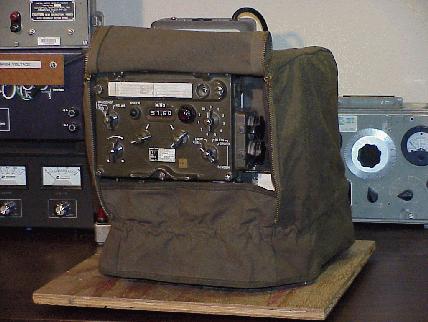
Please note that I do not have any original manuals for this set, and I do not even have a complete set of copied manuals (for example, I do not have any aligment procedures, and I would have great difficulty understanding them even if I had them due to my very poor command of the German language). I cannot provide any further information beyond what is described here at this time, and I cannot provide manual photocopies or other printed information at this time. This page truly contains everything I know about the SEM-25!
Please comment me if you discover any errors in this paper.
I hope you find this information useful!
Description
The SEM-25 is a West German short-range tactical vehicular VHF FM transceiver which was introduced in the 1960’s, and was apparently used until at least the 1980’s. Although surplus SEM-25 radios are not yet very common in the U.S., some have recently appeared on the U.S. surplus market from vendors such as Murphy’s Surplus Warehouse.
The SEM-25 covers 26.00 to 69.95 MHz, in 50 kHz steps. It is all solid-state, except for three tubes in the transmitter power amplifier. A SEM-25 system will typically consist of at least the following items:
- Transceiver chassis
- Control box (may be mounted on front of transceiver, or remotely)
- Mounting/power supply
- Power transient suppressor
- Antenna tuning unit
- Antenna
- Audio accessories ranging from a simple handset to several junction boxes and headsets
- Various cables
More complicated systems may consist of two SEM-25 transceivers and one EM-25 receiver, with lots of audio gear and cabling, thus providing a set with retransmission and intercom features.
So far, I have only obtained a transceiver chassis, control box and mounting, so I cannot provide much information about the antenna, antenna tuning unit, power surge protector or other accessories at this time. The audio connections on the control box and main chassis are compatible with common 1950’s U.S. audio accessories such as the H-33/PT handset and LS-166/U loudspeaker. Pictures I have seen of the correct German audio accessories (well, actually photocopied photocopied photocopies…) suggest that the correct German handset (called an H-33G) appears virtually identical to its U.S. counterpart, and the correct loudspeaker has a case like a U.S. LS-7 loudspeaker with a mounting like a U.S. LS-166. The headset looks a lot like a U.S. H-63/U with an AN/GSA-6 control box. The antenna whip elements are called MS118AK, MS117A and MS116A, and look very similar to U.S. elements with similar names, and the antenna base looks a lot like the U.S. MP-65. The knobs on the control box look just like 1950’s U.S. knobs. I’m really surprised at the similarities between this set and comparable U.S. sets, in spite of the fact that they were designed and built in different countries.
I first learned of the existence of the SEM-25 when I saw a pile of them on the shelves in the famous back room of Murphy’s shop in late 1998. Although I had never been very interested in foreign military gear before, the SEM-25 looked like a neat radio, so I talked my folks into getting me one for Christmas in 1998. My dad and I made the hour-long drive down to Murphy’s shop on Christmas Eve, and I picked out the nicest-looking radio from the pile. It was even gift-wrapped in a stylish olive drab canvas cover!
At the time, Mike was charging $350 for the SEM-25, and $250 for a smaller but similar-looking radio which he called a “SEM-20”. The smaller radio is actually an EM-25 receiver; it’s basically a receive-only version of the SEM-25. It’s easy to get confused about the features and identification of these two radios, because they both use the same control box and share many modules, so the EM-25 is prone to have stickers which say “SEM-25” (or even “SEM-35”; it shares two internal modules with the SEM-35 backpack transceiver) on and inside it, and it will have controls for transmitting functions which it does not perform.
The “SEM” in “SEM-25” is short for “Sender-Empfangsgerät”, which is German for “transmitter-receiver”. Similarly, the “EM” in “EM-25” is short for “Empfangsgerät”, which is German for “receiver”.
Specifications
General
| Modes | Simplex, retransmit |
|---|---|
| Frequency range | 26.00-69.95 MHz |
| Channel spacing | 50 kHz |
| Number of channels | 880 |
| Channel selection | 44 1-MHz bands, 20 50-kHz channels each |
| Programmable channels | 10 |
| Modulation | FM |
| Operation, including frequency selection | Operated from a transceiver-mounted control box, or from a relocatable control box in vehicle (max. cable length 10m) |
| Transmitter operation |
|
| Remote input and output arrangement | From telephone remote control over field phone wires, up to 3 km long, max. resistance 480 ohms |
| Temperature range | Operating range from -45°C to +60°C |
| Overvoltage protector | For transients up to 65V from the battery regulator |
| Power supply | 24V battery supply, negative ground, permissible voltage range 21V to 29V, short term overvoltage up to 32V |
Transmitter
| Output power | High: 15 W Low: approx. 1 W |
|---|---|
| Calling frequency | 1600 Hz |
| Audio input |
|
| Warm-up time | approx. 30 seconds |
Receiver
| Sensitivity | <= 0.5 µV for 20 dB s/n with 1000 Hz modulation and 10.5 kHz deviation |
|---|---|
| Bandwidth | >= 30 kHz at 6 dB points |
| Selectivity | +/- 50 kHz at 80 dB points |
| Audio output |
|
Power Supply
| Voltage | 24V battery (21V to 29V), negative ground, permissible short term overvoltage up to 32V |
|---|---|
| Power requirements, RX | approx. 10 W |
| Power requirements, TX Low | approx. 50 W while transmitting |
| Power requirements, TX High | approx. 80 W while transmitting |
| Power requirements, TX Low or TX High | approx. 29 W when not transmitting |
Sizes and Weights
| Item | Height (mm) | Width (mm) | Depth (mm) | Weight (kg) |
|---|---|---|---|---|
| Control box | 174 | 228 | 75.5 | 2.54 |
| Transceiver | 222 | 268 | 255 | 14.59 |
| Transceiver mount | 120 | 320 | 300 | 9.43 |
| Receiver | 222 | 196 | 255 | 11.08 |
| Receiver mount | 120 | 320 | 230 | 6.68 |
| Antenna tuning unit | 122 | 290 | 110 | 3.70 |
| Overvoltage protector | 93 | 250 | 126 | 2.62 |
| Spares case | 48 | 140 | 140 | 0.73 |
Controls
This section decribes the functions of the controls on the SEM-25 control box.
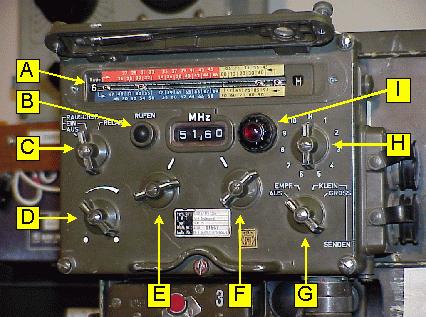
| Ref. | Description |
|---|---|
| A | Channel programming drum (behind cover) |
| B | Call button: Keys transmitter, sends 1600 Hz tone |
| C | Squelch |
| D | Volume |
| E | Manual tuning, 1 MHz steps |
| F | Manual tuning, 50 kHz steps |
| G | Power |
| H | Channel selector (H = manual tuning) |
| I | Power-on light (turn bezel to dim) |
Power Switch Settings (Ref. G)
| AUS: | Off |
|---|---|
| EMPF: | Receive-only |
| SENDEN KLEIN: | Transmit/receive (low power) |
| SENDEN GROSS: | Transmit/receive (high power) |
Squelch Switch Settings (Ref. C)
Note: Squelch is opened by carrier level, equivalent to “old” mode in U.S. radios.
| RAUSCHSP. AUS: | Squelch off |
|---|---|
| RAUSCHSP. EIN: | Squelch on |
| RELAIS: | Relay (retransmit) |
Connectors
This section describes the functions of the external connectors on the SEM-25.
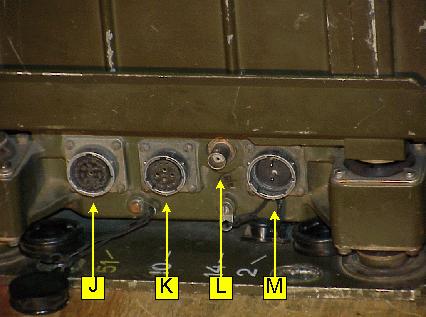
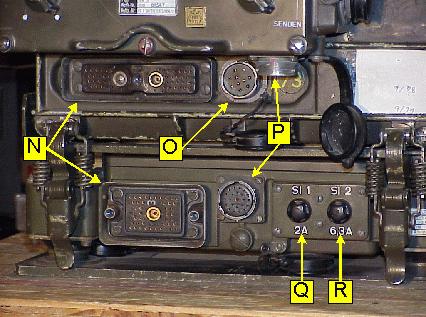
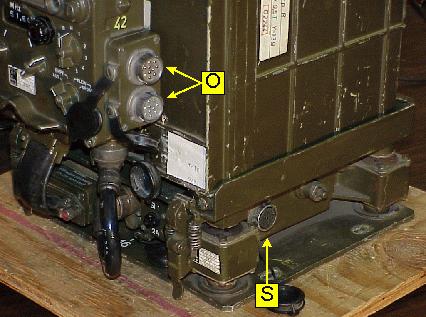
| Ref. | Description |
|---|---|
| J | From transceiver #1 in multi-radio sets |
| K | Antenna tuner control |
| L | Antenna RF |
| M | Power input |
| N | Mounting/transceiver interconnect |
| O | Audio |
| P | Control box/mounting interconnect |
| Q | Receiver fuse (2A) |
| R | Transmitter fuse (6.3A) |
| S | To transceiver #2 or aux. receiver in multi-radio sets |
Modules
This section identifies the SEM-25’s major internal modules. Note that two of the modules (as noted below) are also used in the SEM-35 backpack/vehicular transceiver.
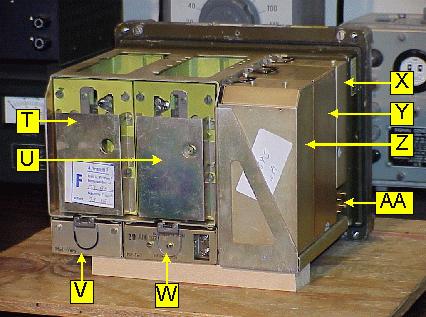
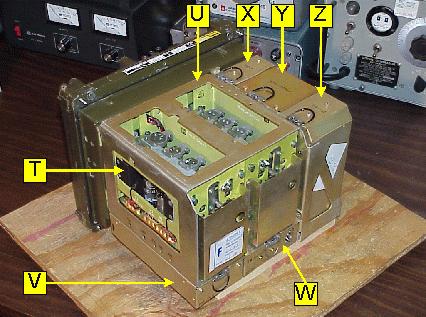
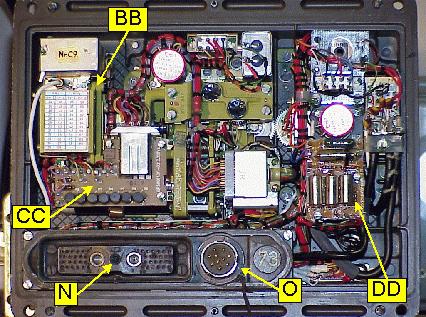
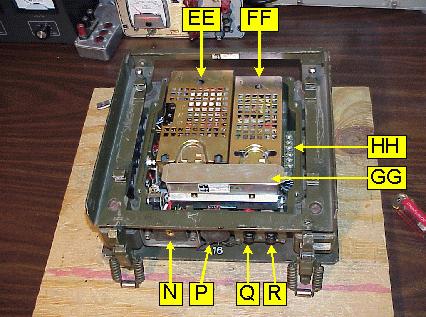
| Ref. | Description |
|---|---|
| N | Mounting/transceiver interconnect (external) |
| O | Audio connector (external) |
| P | Control box/mounting interconnect (external) |
| Q | Receiver fuse (2A) (external) |
| R | Transmitter fuse (6.3A) (external) |
| T | Transmitter RF |
| U | Receiver RF |
| V | Modulator amplifier, 1600 Hz tone generator, and 11.5 MHz discriminator for automatic frequency control (AFC) of transmitter |
| W | Audio amplifier |
| X | Receiver power supply and control amplifier |
| Y | Frequency synthesizer (also used in SEM-35) |
| Z | IF (Intermediate Frequency) module (also used in SEM-35) |
| AA | Plugs for test box |
| BB | 10-frequency crystal oscillator |
| CC | Receiver servo |
| DD | Transmitter servo |
| EE | Transmitter power supply |
| FF | Motor drive power supply for external antenna tuner |
| GG | Relays for interconnect of multiple transceivers |
| HH | 600 ohm balanced audio connections |
Internal Adjustments
While we have the case open, here are some of the major internal adjustments:
| Control | Label | Location | Function |
|---|---|---|---|
| R36 | Rauschperre | Audio amp. (Ref. W) | Squelch level |
| R5 | NF-Pegel | Audio amp. (Ref. W) | Audio level |
| R13 | Eing. | Mod. amp. (Ref. V) | Mod. amp. input gain |
| R26 | Ausg. | Mod. amp. (Ref. V) | Mod. amp. output gain |
| R38 | Tacho | Rx power supply (Ref. X) | Stepping speed trim (?) |
Schematics
The diagrams in this section were scanned at 150 pixels per inch, and you will probably need to use an external graphics-editing program to print them (simply clicking your browser’s “Print” button probably won’t work well).
The diagrams were all scanned from photocopied manuals, and the originals are just as blurry as the scans, so don’t bother asking for photocopies of the schematics! :-)
Block Diagrams
| Description | File | Size |
|---|---|---|
| Transceiver | blk01.gif | 1100×1338, 33k |
| Frequency selection | blk02.gif | 1100×1540, 44k |
| Receiver | blk03.gif | 1172×946, 20k |
| Transmitter | blk04.gif | 1082×888, 12k |
| Antenna tuner (external) | blk05.gif | 948×1240, 15k |
Schematic Diagrams
The “Ref.” column shows the corresponding reference letters from the module identification pictures (where applicable), to help you figure out which part of the radio is described by each schematic.
| Description | Ref. | File | Size |
|---|---|---|---|
| Wiring (main chassis) | — | sch01.gif | 1744×1232, 90k |
| Transmitter RF | T | sch02.gif | 1744×1232, 70k |
| Receiver RF | U | sch03.gif | 1744×1232, 70k |
| Modulator amplifier module | V | sch04.gif | 1744×1232, 62k |
| Audio amplifier module | W | sch05.gif | 1744×1232, 55k |
| Receiver power supply module | X | sch06.gif | 1744×1232, 66k |
| Frequency synthesizer module | Y | sch07.gif | 2381×1231, 117k |
| IF module | Z | sch08.gif | 2539×1232, 84k |
| 10-freq. crystal oscillator | BB | sch09.gif | 1193×768, 17k |
| Receiver servo | CC | sch10.gif | 1196×778, 38k |
| Transmitter servo | DD | sch11.gif | 1172×809, 19k |
| Control box | — | sch12.gif | 3042×1226, 104k |
| Wiring (mounting) | — | sch13.gif | 1744×1232, 94k |
| Transmitter power supply | EE | sch14.gif | 778×1159, 36k |
| Motor drive power supply | FF | sch15.gif | 1187×772, 26k |
| Interconnect relays | GG | sch16.gif | 1197×794, 36k |
| Transient protector (external) | — | sch17.gif | 1201×790, 34k |
| Antenna tuner (external) | — | sch18.gif | 1744×1232, 68k |
English/German Translations
This section lists rough translations of some German words, phrases and abbreviations as used in the SEM-25’s schematics, module labels, etc. My command of German is very poor, so there may be mistakes here… please comment if you can correct any of my translations!
- Abstimmgerät
- Radio tuner (tune + apparatus)
- Abstimmteil
- Radio tuner section (tune + part)
- Additionsstufe
- Addition stage
- Anschluß
- Connection
- Antennen
- Antennas
- Antrieb
- Drive, driver, motor
- Ausgang
- Output
- Bausteinträger
- Component carrier
- Bauteile
- Components
- Bedien
- Control head
- Begrenzer
- Limiter
- Blockschaltbild
- Block diagram
- Bordbatterie
- On-board battery
- Bordverstärker
- Intercom (on-board + amplifier)
- Diskriminator
- Discriminator
- Eingang
- Input
- Einsatz
- Part, component
- Empf.
- Receive or receiver
- Empfänger
- Receiver
- Endstufe
- Output stage
- erdfrei
- Balanced (i.e. “balanced line”; literally, “ground-free”)
- Frequenzaufbereitung
- Frequency synthesizer
- Funk
- Radio
- geschlossen
- Closed
- gezeichnet
- Drawn
- gross
- Large
- Grundplatte
- Mounting (base + plate)
- HF
- Radio frequency (RF)
- Hinweis
- Note
- im
- In
- Kanalwahl
- Channel selection
- klein
- Small
- Leitung
- Line, wire
- Ltg.
- Line, wire
- Masse
- Common, ground
- Mischstufe
- Mixer
- Netzgerät
- Mains power adapter
- NF
- Audio frequency
- Oberton
- Overtone
- offen
- Open
- Oszillator
- Oscillator
- Prüfgerät
- Test meter
- quarz
- Quartz
- rauschperre
- Squelch (noise + stop)
- relais
- Relay, retransmit
- rufen
- Call
- ruhezustand
- Off-state
- senden
- Transmit
- Sender
- Transmitter
- Servoverstärker
- Servo amplifier
- Steuerverstärker
- Servo amplifier
- Stromversorgung
- Power supply
- Teil
- Part
- Transientschutz
- Transient protector
- Treibertufe
- Driver stage
- Trennstufe
- Divider stage
- Umwandler
- Converter
- Verstärker
- Amplifier
- Vorstufe
- Input stage
- ZF
- Intermediate frequency (IF)
Credits
This work would not have been possible without the generous assistance of the following people:
Pictures were taken with a Sony MVC-FD91 digital camera. Reference letters were added with Visio 4 on a Windows NT box; all other image editing was performed with xv and gimp on a Redhat Linux system.
Scanned documents were scanned with a Umax Astra 1220S scanner and the SANE software under Redhat Linux, and then edited with xv and gimp.
Hello,
I have a SEM-25 since several years…
This morning, i decided to plug a 24v power supply and to see what happens…
The receiving part is all ok
But not in transmit. I try the “Call button” with the two modes (LOW and HIGH RF) but nothing.
I just listen an internal relay.
Perhaps no tube ? Hi
I am searching the TX fuse but i did not found. On the panel it’s look like not similar than on your pictures.
Some ideas ?
I have a specific page where you can see my beautifull SEM-25. On this page i have re-writen the first pages of your nice web site and i hope that you agree with this.
Thanks a lot
Best 73
JEAN-LUC
F6HOY
http://www.f6hoy.com/sem-25/
Hello Jean-Luc !
I’ve taken a look on your SEM 25-Homepage and I found the reason why your SEM 25 will not transmit: I’m sure that the unit you own is NOT a SEM 25 but a EM 25. The Housing of the unit on top of the mounting (Receiver- or Transmitter/recceiver-unit) ist to small.
On the frontside of the mounting there are 2 fuses – a 2A-fuse for the Receiver and a 6,3A-fuse for the transmitter. On your photos the 2A-Fuse is positioned on the right side, on the Frontside is NO Fuse. However, your unit is marked als “SEM 25” with a serial-number which is written by hand on the type shield, usually the serial number is printed . The only way to find out what’s wrong is: Open the mounting. Inside the TRX-Mounting are 3 Plug-in Units (Antrieb-Stromversorgung, Sender-Stromversorgung and Relaiseinsatz). If there are only 2 (Antrieb-Stromversorgung and Relaiseinsatz) the mounting belongs to the EM 25. 2.Step: Remove and open the “Main Group”on top of the mounting. Be very careful when opening the clamps !!! If there are 3 tubes on the right side, it’s a transmitter-receiver-unit, if there are no tubes, it’s a Receiver. You can compare the internal view of your units with the Pictures on Mark’s Homepage.
I hope this informations are helpful for you.
73,
Klaus, DL4FCY
Hello Jean-Luc !
On one of your photos i could see a part of the german stock-no. (Versorgungsnummer). It belongs to the mounting of the RECEIVER EM 25 (Stock-no/Versorgungsnummer 5820-12-141-1227).
It is definitive Receiver…
73,
Klaus, DL4FCY
Hi Jean-Luc !
When switching on the Transceiver, you’ll have to wait a couple of minutes (2-3) before activating the Transmitter, until the tubes are “heated”. If you are changing the frequency, is the tuning circuit running ? If not, it could be a problem in the “Transmitter Power supply” (in German: Sender-Stromversorgung) which is located inside the mounting. On Marks Photography it is marked with “EE”.
I hope this will help you to get your sem25 back on air !
73,
Klaus, DL4FCY
Hi Klaus,
Thanks a lot.
Yes, when i change frequency i can listen the circuit running.
I think that i am going to open it.
I will be at home tomorrow and i will look this…
73
Jean-Luc
F6HOY
Wonderful Web Page…..
Sem35 Alignment help, Radio off just little between RECV TRX . Any Help Please.ThankX Mark
Hi Mark !
If you have the occassion to get a test-set (Sendeempfänger-Prüfgerät) SEP 35 then use it !. This is a test-set which was developed to check the transceiver SEM 35-circuit and alignments in a very easy and quick way-and in the TDv which belongs to the test-set there is a list what to do if a measurement is not ok… Unfortunately I also haven’t got the TDv for this radio yet.
For the SEM 25 this test-set cannot be used, but there exists a separate test-set SEP 25.
Here in Germany the test set is available from time to time from the surplus-dealers.
Without the test-set AND without the TDv it will be very hard to find the reason why your radio is not working.
73,
Klaus, DL4FCY
Hi
I have a simple question .
What is the length of the ideal antenna with an AGAT ?
Thank’s
73
Laurent
Hello Laurent !
The ideal length is the original Antenna : Antenna Base MP65, and each one of the mast sections MS-116, MS-117 and MS-118 (or the US-Equivalent types).
The complete length of the Antenna is about 2,25m
73,
Klaus, DL4FCY
Hello Laurent !
The ideal length of the Antena ist the original antenna: Antenna Base MP-65 and each one of the mast sections MS-116, MS-117 and MS-118 (or US-equivalent types). The complete length is about 2,25m.
73,
Klaus, DL4FCY
Hello !
I am searching for somebody who is VERY experienced in the SEM 25….. Since a couple of weeks my SEM 25 doesn’t transmit anymore. A measurement with the SEP 25 showed missing grid-voltages and tensions in the transmitter, but the Change of the plug-in-modules (Transmitter power supply) was’t succesful.
The failure is: No Transmission (not on the lower band and not on the upper band), no function of the AGAT, the frequency display of the AGAT is not the same than the frequency selected with the controlbox. the Receiver is working well.
Does anybody have an idea ?
73,
Klaus, DL4FCY
Hello everybody !
Yesterday I could solve the Problem with my sem 25-transmitter. At least there was 3 Problems, I write them here for everybody who fights the same fight like me…
Problem 1: Inside the Cable no. 16 (the connection cable between the remote box and the mounting base, the line which transports the “upper-/lower-band-Information to the Transceiver) was broken – I don’t have any idea how this could happen…
Problem 2 : Inside the relay unit which is located inside the mounting base a relay was defective, or one of the wires’ soldering didn’t have a good contact anymore. The next Project will be to disassemble the complete unit, check again every single relay-contact, and change ALL cables inside the unit, so that I will have a spare unit.
Problem 3 : The antenna-tuning-unit (AGAT) did not work anymore.
actually the unit works fine again, but i will make some measure-sessions with my test-box SEP 25, so that the alignment will be optimized.
Then the next dx-session can come !!!
73,
Klaus, DL4FCY
Hi Klaus
Finally I installed the sem 25 on the MUNGA, I connected the AGAT and the antennas. I connected the instrument for the verification of stationary waves.
All right, but from 26 Mhz to 30 Mhz the transmitter does not work, then it emits radiofrequency.
From 30 MHz to 54 MHz I can get a good issue, over 54 MHz the stationary rise considerably.
Do you have some advice?
Did I mistakenly mount the antennas?
Thank you
73,
Giovanni IW2BZO
Hello Giovanni !
The first thing I can recommend you is to check, if the frequency you have tuned to the remote-box is the same shown on the AGAT-display. For example: If the frequency you have tuned on the remote-Box is 29,60 MHz, then the AGAT-display (the little “window” on the upper side of the AGAT-unit) must show 29,5 MHz. If you change the MHz-Steps, the frequency displayed from the AGAT must change too. Also very important is the switching when changing from the lower- to the upper band and versa (between 46 and 47 MHz). The “MHz” always mut be the same, on the control-box and on the AGAT.
Do you have rf-output beween 26 and 30 MHz when you press the ptt ? You can monitor your output-signal on a fm-receiver. Do you use an original antenna (base mp-65 and each on mast-section ms-116, ms-117 and ms-118) ? The AGAT is designed to work with this configuration ! Maybe the AGAT is not correct aligned with the antenna you use between 26 and 30 MHz. Normally the antenna sytem should be aligned once a year over the complete frequency range. Switch a swr-meter between transceiver and AGAT, press the ptt and align the agat for a minimum reflecting power. Repeat this für every MHz-step. Unfortunately, the AGAT is not able to do own measurements an alignments with the antenna (the construction era of the sem 25 with the AGAT is the sixties !).
I hope this is helpful for you !
73,
Klaus, DL4FCY
Thank you Klaus
the weekend I start to work.
73 + 44
Giovanni IW2BZO
Hello SEM-25-Community !
I have a Problem with my SEM 25, and I could locate it to the interconnect relay unit which is located inside the mounting. The Problem are soldering Points at the relays. If the cables are moved for measuring, the wire can break at the soldering Point, and when the insulation was melted when the solderings was made, it feels as if the solderings are ok – but they aren’t !!! So I removed all cables, and now I want to rebuild them with new cables. When refering to the circuit diagram on this side (made by the Fernmeldeschule des Heeres), I saw that there are differences between this circuit diagram and the circuit diagram in the official Manual (TDv 5820/046-40 Bild 16). Actually I’m checking the circuit diagrams from both sources , Information will follow…
73,
Klaus, DL4FCY
Hi Marc !
I found a relatively complete Version of the german manual for the SEM 25, including circuit diagrams and aligning procedures. If you are interested, I can mail it to you. The size of the Manual is about 25 MB. Can you give me a E-Mail-adress ?
73,
Klaus, DL4FCY
I think that my email would choke on a 25M file. Is there any other way that you could share it? Afterwards, I would be happy to host the file here on my web site if you would like.
Hi Marc !
On the top of this page you wrote about a “SEM 20” – I searched about it, but I couldn’t find anything that such a Radio existed. Can you send me further informations about this set, maybe photos ?
Many thanks, 73,
Klaus, DL4FCY
It was an EM-25. The dealer I got my SEM-25 from was mistaken about its model number.
Hello @ all !
I am very happy to announce that my SEM 25 is working again !!!! I found a defective relay inside the relay interconnect module which is located inside the mounting, the band information cable F inside cable 16 (connection between the control-box and the mounting) had no contact…, and the driver motor inside the tuning unit (AGAT) was defective. Now the radio is working fine again-It’s been a long way…
IMPORTANT INFORMATION FOR ALL SEM 25-USERS : Be careful when using schematic diagrams from the “Fernmeldeschule des Heeres” !!! In some cases there are differences between this schematics and the schematics from the “official” Manual (TDv 5820/046-40). At all differences I found that the schematics in the TDv are correct !
I’ve sent the complete TDv to Mark – maybe there is a chance to host it here ?
73,
Klaus, DL4FCY
Klaus,
Do you have schematics for the control box/audio here listed as O. I am trying to make a headset with ANR to work but cant get the right combination to get to work perfectly.
Hi,
I am trying to connect a new head set with ANR to a SEM-25 but I cant get the pins to match. My head set has 7 cable/functions: Speaker +, Speaker -, Mic +, Mic -, ANR, and 2 PTT (one for speaker and one for mic).
Here is what for a fact it is working: Speaker + with pin A, Speaker – with pin B, ANR with pin E and PTT for speaker with pin F.
So I am missing MIC + and – and its PTT any thoughts?